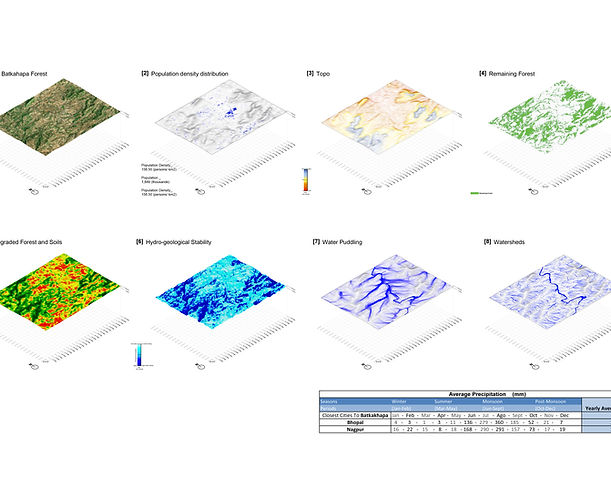
TERM2
Visualizing
| Rendering V-ray + Adobe Photoshop
25 Students Max _ 4weekly sessions of 4hours each
Students will focus on Importing & exporting complex 3D Geometry for Rendering, including colour meshes. The software introduced to the students will be 3ds Max/V-ray render as well as Wireframe rendering. Lighting and Material properties will also be explored on a step by step image rendering.
Finally basic Photoshop editing, Layering and Blending will be introduced.
Session 1: 3Dsmax Interface Introduction + Introduction to V-ray
Session 2: V-ray Global settings + V-ray Materials + Lighting + Physical Cameras + HDRI
Session 3: V-ray Proxy + Object Paint
Session 4: Photoshop/layering/Filters /Fill
////////////////////////////////////////////////////////////////////////////////////////////////////
Term 1:
Nurbs + Mesh Modelling and Satellite Pixel Processing
| Rhinoceros + Photoshop + Illustrator
25 Students Max _ 4weekly sessions of 4hours each
Students will be introduced to Rhinoceros 3D modeling environment with particular focus on Nurbs and Mesh modeling. They will work with global satellite database from which they will learn to import data to produce accurate 3D datascape and gradient fileds.
A set of modeling techniques will focus of transitioning from 2D to 3D and back to 2D, deploying systematic and rigorous drawing protocols.
Session1:
-Introduction to rhino and layout, main commands, layering, properties etc.
Session2:
-Introduction to global satellite databases (MicroDem, Google earth, STRM 4.1)
-Generation of surfaces of topography and Contouring and surface tessellation.
Session3:
-Introduction to Landsat resources.
-Data pixel processing of Satellite imagery.
Session4:
-High-resolution satellite imagery Pixels isolation in Photoshop.
-Pixel conversion to vector files in Illustrator to be exported as Dwg.
////////////////////////////////////////////////////////////////////////////////////////////////////

TERM3
Parametric environmental modelling
| Geco/Ecotect / Heliotrope/ Vasari/Sonic
20 Students Max _ 4weekly sessions of 4hours each
The course uses the environmental analysis capabilities of other Rhino-based design environment to model both the micro and macro performances of neighbourhoods and cities regarding thermal energy, accessibility and daylighting.
Session 1: Geco/ Ecotect for Rhino (Solar and Shading)
Session 2: Winrar/Vasari/Sonic (Wind analysis)
Session 3: Heliotrope (Solar and Shading)
Session 4: Designing with environmental simulation
////////////////////////////////////////////////////////////////////////////////////////////////////


Associative Modelling
| Grasshopper
25 Students Max _ 4weekly sessions of 4hours each
Students will be introduced to Grasshopper plug-in, familiarize the layout and the basic notions of associative modelling. Initially they will be following a step by step example of generating algorithmic patterns from an external database. They will then create a 3D urbanscape differentiated in relationship to input data and a set of proximity relationships.
They will then learn how to export "baked" geometry and 2D lines and manipulate them in illustrator for final editing of scale parameters, line parameters, text and colour.
Session 1:
-Introduction to grasshopper plug-in for rhino. The students will step by step compose a grasshopper script to process images and generate datascapes from grasshopper.
Session 2: Introduction to algorithmic modelling and algorithmic techniques. Step by step generation of algorithmic patterns and data extraction.
Session 3: Introduction to DataScapes with multiple dependencies.
Session 4: Exporting of geometry and 2D lines and introduction to illustrator. Main editing of scale parameters, line parameters, text and layering. Students will be asked to produce a finalized drawing for printing.
////////////////////////////////////////////////////////////////////////////////////////////////////
Associative modelling advanced and 3D printing
| Grasshopper + Weaverbird +MakerBot 2x
20 Students Max _ 4weekly sessions of 4hours each
Students will follow a step by step algorithmic model production and parametric meshing with weaverbird.
In the advanced design session students will be assigning physics to models as well as generating text and colour as performance indexing.
Introduction of Abs and Pla plastic 3d printing with generation of G-code and support structures, software setup and file preparation.
Final sanding, smoothing and colouring for 3D printed models.
Session 1: GH + Data trees
Session 2: GH + mesh edit+ Weaverbird + Kangaroo + mesh (+) + Preview data
Session 3: Rhino Mesh analysis & repair
Session 4: Makerware + Maker Bot 2X
////////////////////////////////////////////////////////////////////////////////////////////////////



Parametric environmental modelling
Maya + GH Maya Particle Importer
|Polygon Modelling/Physics: Particles+Fluids+Fields/GH Maya Particle Importer
20 Students Max _ 4weekly sessions of 4hours each
The course will cover how to navigate and use Maya’s interface, while simultaneously they learn how to work with low polygon modelling. Also students will learn how to establish a work flow between Maya and Rhino3d by exporting/importing IGS and OBJ files formats.
Introduction of Maya physic will explore the influence of world forces into particles and fluids systems. The resulting P.simulation will be imported into GH to extract data attributes of the particles so they can be integrated into an associative modelling.
Session 1: Maya interface + low polygon modelling + workflow between rhino and Maya
Session 2: Maya Particles + fields
Session 3: Maya fluids
Session 4: GH Maya particle Importer
////////////////////////////////////////////////////////////////////////////////////////////////////
© 2014 MArch UDII | BPro UCL. All rights reserved
